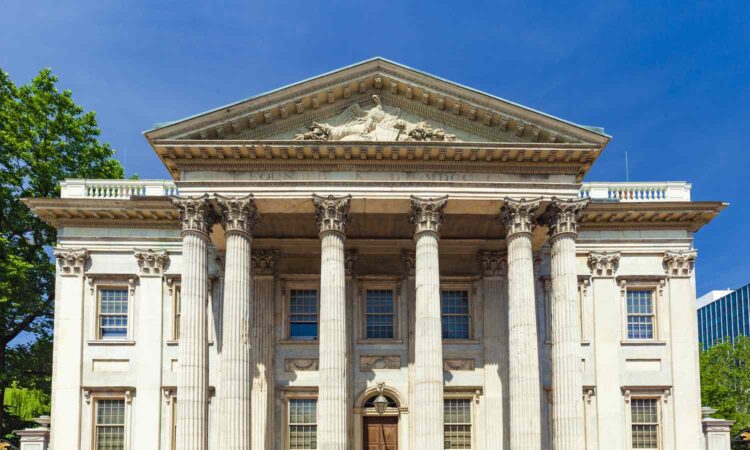
What Is a National Bank?
In the United States, a national bank is a commercial bank that the Office of the Comptroller of the Currency (OCC) charters and supervises. However, many people also refer to national banks as any financial institution operating nationally compared to local banks operating in one city, state, or region.
Key Takeaways
- In the U.S., a national bank is a commercial bank chartered by the Office of the Comptroller of the Currency (OCC).
- The nation’s four largest banks comprise 60% of the entire banking system’s assets.
- A national bank’s FDIC insurance protects up to $250,000 in an individual’s checking accounts, savings accounts, certificates of deposit, and money market deposit accounts.
How National Banks Work
In the U.S., a national bank is a commercial bank that engages in various financial services, such as accepting customer deposits and offering loans. The federal Office of the Comptroller of the Currency charters national banks; state banks are chartered by state banking agencies.
The OCC regulates national banks with regard to banking activities and operations. As of 2023, the OCC oversees 1,062 national banks. However, the nation’s four largest banks make up about 43% of the entire banking system’s assets.
As of June 2023, these four national banks are:
National banks are required to be members of the Federal Reserve System, and a national bank is an investing member of its district Federal Reserve Bank. National banks belong to the Federal Deposit Insurance Corporation (FDIC). The FDIC insures eligible customer deposits for up to $250,000.
National banks may facilitate daily transactions with their local Federal Reserve Bank (also called the Fed), such as Fed bank wires. National banks must generate call reports to the Fed each quarter and ensure these reports are made public.
National banks in the U.S. and worldwide are essential in shaping a country’s financial system. An efficient banking system, whether through a central bank or the U.S. Federal Reserve, is critical for economic stability, especially during times of recession or to help weather downturns in the economy.
National banks in the U.S. and worldwide are essential in shaping a country’s financial system. An efficient banking system, whether through a central bank or the U.S. Federal Reserve, is critical for economic stability, especially during times of recession or to help weather downturns in the economy.
History of National Banks
Alexander Hamilton, the first Secretary of the Treasury, was instrumental in forming the first national bank in the United States. The structure, in Philadelphia, Pennsylvania, was completed in 1797 and is a National Historic Landmark today.
First Bank collected taxes, paid government bills, and printed banknotes, similar to a national currency. Only First Bank notes could be used to pay federal taxes. The bank’s 20-year charter began in December 1791, but Congress didn’t renew it when it expired in 1811.
In 1863, President Lincoln’s signature on the National Currency Act established the Office of the Comptroller of the Currency. The OCC would help manage nationally chartered banks and create a uniform national currency.
In 1913, the Federal Reserve Act created the Federal Reserve System to serve as the national bank of the U.S. while propping up a new national currency. Before this, around three-fourths of all U.S. banks were state-chartered, with fragile capitalization.
An amendment to the Glass–Steagall Act of 1933 introduced the Federal Deposit Insurance Corporation (FDIC) to help restore public confidence during ongoing bank failures.
National Bank Examples
As mentioned above, national banks in the United States are typically commercial banks. The Office of the Comptroller of the Currency maintains an up-to-date list of national banks and federal savings associations it charters and regulates. Examples of active national banks the OCC regulates include:
In May 2022, the OCC chartered Houston, Texas-based Agility Bank, a woman-owned and woman-led bank categorized as a minority-led institution (MDI) national bank.
In May 2022, the OCC chartered Houston, Texas-based Agility Bank, a woman-owned and woman-led bank categorized as a minority-led institution (MDI) national bank.
Frequently Asked Questions (FAQs)
What Is a National Bank Charter?
A national bank charter, as granted by the federal government, allows an institution to do business as a bank. When starting a new financial institution, the owner applies for a state or national bank charter. This charter allows the bank to offer customers financial services—accepting deposits and providing loans, for example. Since 2009, there have been far fewer new commercial bank charters compared to previous decades.
Who Is Responsible for Supervising National Banks?
The Office of the Comptroller of the Currency (OCC) supervises all national banks. The OCC is an independent bureau of the U.S. Department of the Treasury. The National Credit Union Administration supervises federal credit unions.
What Is a National Bank Holiday?
A national bank holiday is a holiday observed by the U.S. Federal Reserve System. On this day, financial services typically close nationwide. National bank holidays in the U.S. include Martin Luther King Jr. Day, Juneteenth National Independence Day, Columbus Day, and Christmas Day.
The Bottom Line
National banks are an important element of the federal banking system, which is designed to encourage public trust through safety and resilience while still encouraging banks to innovate products and services that customers and businesses need. Federal regulation and FDIC insurance help reassure the U.S. public about national banks and their services.





